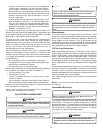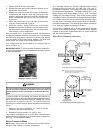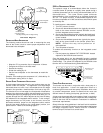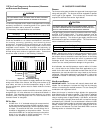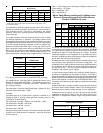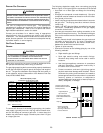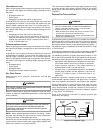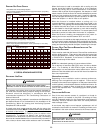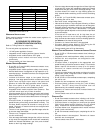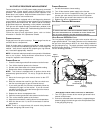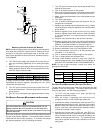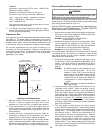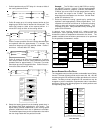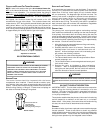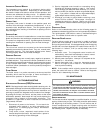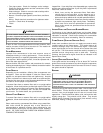Special offers from our partners!

Find Replacement BBQ Parts for 20,308 Models. Repair your BBQ today.
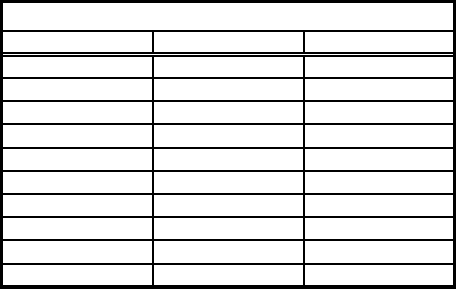
23
• If the two-stage thermostat changes the call from high heat
to low heat, the control will immediately switch the induced
draft blower and gas valve to their low stage settings. The
circulator blower will remain on high heating speed for
thirty seconds before switching to the low heat circulating
speed.
• R and W1 (or R and W1/W2) thermostat contacts open,
completing the call for heat.
• Gas valve closes, extinguishing flame.
• Induced draft blower is de-energized following a fifteen
second post purge. Humidifier terminals are de-energized.
• Circulator blower continues running for the selected heat
off delay period (90, 120, 150 or 180 seconds). The speed
run during this period depends on the last heat call provided
by the thermostat.
If the last call for heat was a call for high heat, the air
circulating motor will run on the high heating speed for
thirty seconds and then switch to the low heating speed for
the balance of the heat off delay period
• Electronic air cleaner terminals is de-energized
• Circulator blower ramps down to OFF during the 30
seconds following the heat off delay period.
• Furnace awaits next call from thermostat.
NORMAL COOLING SEQUENCE - INTEGRATED I GNITION CONTROL
• R and YLO/G or Y/G thermostat contacts close, initiating a
call for cool.
• Integrated control module performs safety circuit checks.
• Outdoor fan and compressor are energized to their
appropriate speed.
• Circulator blower is energized on the appropriate cool
speed following a fixed five second on delay. The circulator
blower requires 30 seconds to ramp up to full speed.
Electronic air cleaner terminals are energized with
circulator blower.
• Furnace circulator blower and outdoor cooling unit run their
appropriate speed, integrated control module monitors
safety circuits continuously.
• R and YLO/G or Y/G thermostat contacts open, completing
the call for cool.
• Outdoor fan and compressor are de-energized.
• Circulator blower continues running for a cool off delay
period. The OFF delay time and airflow level are
determined by the selected ramping profile.
• Electronic air cleaner terminals and circulator blower are
de-energized.
• Furnace awaits next call from thermostat.
CONSTANT F AN
• R and G thermostat contacts close, initiating a call for fan.
• Integrated control module performs safety circuit checks.
• Circulator blower is energized on continuous fan speed
(56% of high stage cooling) following a five (5) second
delay. Electronic air cleaner terminals are energized.
• Circulator blower runs, integrated control module monitors
safety circuits continuously.
• R and G thermostat contacts open, completing the call for
fan.
• Circulator blower is de-energized. Electronic air cleaner
terminals are de-energized.
• Furnace awaits next call from thermostat.
Furnace Input
Filter Size (in
2
)
Type
45M 160 Permanent
68M 241 Permanent
90M 320 Permanent
115M 400 Permanent
135M 370 Permanent
45M 320 Disposable
68M 483 Disposable
90M 640 Disposable
115M 800 Disposable
135M 738 Disposable
Permanent Nominal 600 F.P.M.
Dis
p
osable Nominal 300 F.P.M.
Minimum Filter Sizes
HORIZONTAL I NSTALLATIONS
Filters must be installed in either the central return register or in
the return air duct work.
XI. SEQUENCE OF OPERATION
(INTEGRATED IGNITION CONTROL)
Refer to Timing Charts for sequencing.
The normal power up sequence is as follows:
• 115 VAC power applied to furnace.
• Integrated control module performs internal checks.
• Integrated control module flashes LED lights.
• Integrated control module monitors safety circuits
continuously.
• Furnace awaits call from thermostat.
NORMAL HEATING SEQUENCE
• R and W1 (or R and W1/W2) thermostat contacts close,
initiating a call for heat.
• Integrated control module performs safety circuit checks.
• Induced draft blower is energized on high speed for a 15-
second prepurge. Humidifier terminals are energized with
induced draft blower.
• Induced draft blower steps to low speed following
prepurge. Low stage pressure switch contacts are closed.
• Igniter warm up begins upon step to low speed and
presence of closed low stage pressure switch contacts.
• Gas valve opens at end of igniter warm up period,
delivering gas to burners and establishing flame.
• Integrated control module monitors flame presence. Gas
valve will remain open only if flame is sensed.
• If the thermostat call is for low heat, gas valve and induced
draft blower will continue on low stage. If the call is for high
heat, the gas valve and induced draft blower will change to
high stage.
• Circulator blower is energized on the appropriate heat
speed following a fixed thirty second blower on delay. The
circulator blower requires 30 seconds to ramp up to full
speed. Electronic air cleaner terminals are energized with
circulator blower.
• Furnace is now operating on the specified stage called for
by the two-stage thermostat.
• Furnace runs, integrated control module monitors safety
circuits continuously.
• If the two-stage thermostat changes the call from low heat
to high heat, the integrated control module will immediately
switch the induced draft blower, gas valve, and circulator
blower to their high stage settings.



